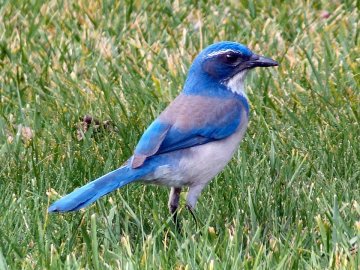
How can you attract bluebirds to your yard? They are beautiful creatures. And they eat bugs, too.
With their brilliant plumage and enchanting “chur-lee” song, bluebirds have become one of North Americas most adored bird species. They can be found throughout the United States, Mexico and in the higher elevations of Canada and Central America. The following information provides ways on how you can attract bluebirds to your yard for enjoyment and help in protecting them.
Provide Suitable Habitat: Bluebirds prefer open, grassy areas such fields, woodland clearings, orchards, gardens and large lawns. Open areas with surrounding trees and other perching spots are best. They rarely nest in wooded areas and tend to be more comfortable where vegetation is kept short by mowing or grazing.
Provide Food Sources: Bluebirds eat large amounts of insects. Sixty to eighty percent of their diet consists of insects like beetles, caterpillars, grasshoppers and spiders. They like to perch along open areas and swoop down on their prey. They also supplement their diets with fruits and berries such as wild grapes, currants, sumac, blackberry, raspberry, mistletoe, elderberry and juniper. Planting scattered fruit and berry sources in your yard can greatly enhance attracting them. You can also try offering hanging fruit suet or chopped fruits, berries and meal worms (which they love) on an open platform feeder.
Keep the Habitat Chemical Free: Insecticides and pesticides destroy the food sources bluebirds need to survive. A yard that offers a wide variety of insects is welcoming to bluebirds. A major cause for declines in bluebird populations has been the wide-spread use of these chemicals. Once established in your area, the bluebirds will act as natural insect controllers.
Provide a Water Source: Bluebirds need water for drinking and bathing. Providing a birdbath or ground level water source, with nearby spaces to perch, will keep them from venturing away from your yard to locate another source.
Offer Nesting Areas: Providing nesting sites for bluebirds is important in attracting them. In the wild, they nest in tree cavities like old woodpecker holes. When there is a lack of natural sites they will quickly utilize man made bluebird houses.
Offer the Proper Type of House: Bluebirds are picky about the design of their homes. The floor should be 5 inches x 5 inches with a height of 10 to 12 inches. The diameter of the entrance hole should be 1½ inches and located 6 to 8 inches above the floor. It is essential that the box be ventilated with holes at the top and drainage holes on the bottom.
Mount Bluebird Boxes Properly: It is preferable to mount the boxes on fence posts or poles to provide protection from predators. The bottom of the box should be placed four to five feet from the ground. There is no particular direction bluebirds prefer for the opening, but it is best to face the opening away from prevailing winds. It is also important to face the opening towards a nearby tree or scrub so that when the young leave the nest they have a safe perch available. If more than one box is mounted in an area, the boxes should be placed at least 100 yards apart because bluebirds are territorial during nesting season.
Provide Nesting Materials: Nests are generally made of soft grasses and smaller materials like pine needles. Building a nest is very time consuming, so providing nesting materials is a good way to keep bluebirds in your yard. The nest is built entirely by the female who can make hundreds of trips to gather enough material for completion. Placing nesting materials in hanging suet feeders or in the crooks of tree bark will help limit her number of trips.
Check Nesting Boxes for Problems: When unoccupied, it is important to check and clean nesting boxes. Old nests should be cleaned out and the the interior scrubbed with a light bleach solution. Check in early spring to make sure other animals like mice or sparrows have not occupied boxes during the winter months.
Monitor Predators: The major predators of bluebirds are cats, raccoons, opossums, foxes and snakes. If you have a cat, try to limit its activity in areas with bluebirds or place a bell on its collar. Properly mounting bluebird boxes can effectively deter threats from other types of predators.
Limit Human Noises: Bluebirds like peaceful, quiet surroundings. Any loud human noises will frighten them away. This is especially true during mating and nesting seasons. By limiting human noises and activities, you provide an area that bluebirds will be willing to share with you.




